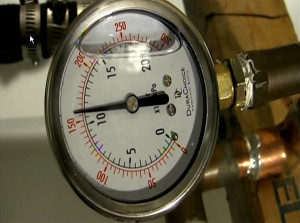Pricing
Collectors are available in Stainless Steel or Aluminum manifolds... SRCC Certified...
SFB-20's (47mm x 1500mm) are $475.00. "Hyper" reflectors add $47.50
SFB-30's (47mm x 1500mm) are $690.00. "Hyper" reflectors add $72.50
SFB-15's (58mm x 1800mm) are $425.00. "Hyper" reflectors add $35.00
SFB-20's (58mm x 1800mm) are $575.00. "Hyper" reflectors add $47.50
SFB-30's (58mm x 1800mm) are $795.00. "Hyper" reflectors add $72.50
All collector tubes are HRG (Hail Rated Glass). This is new and improved giving the glass better resistance to hail and other impacts.
Spare glass tubes (HRG, Glass only) 47mm x 1500mm are $10.00 ea. Spare glass tubes (HRG, Glass only) 58mm x 1800mm are $15.00 ea. The handling/packaging fee for spare glass depends on how many tubes are purchased.
There is a $37.50 testing/handling fee on all collectors. This covers basic handling and pressure testing of the units.
The crating fee on 47mm collectors is $77.50, and $97.50 on 58mm collectors shipped with "Shock Watch" (tm). This covers special hand made SAC's to minimize glass breakage. This fee applies ONLY to units that are shipped through the freight system.
Qty discounts (10+ units) are available as well as large qty (30+ units) special pricing.
All solar collectors include: 15, 20 or 30 tube Stainless Steel or Aluminum manifold, 15, 20 or 30 full glass collector tubes, Stainless Steel or Aluminum mounting frame, Stainless Steel nuts and bolts for frame, rubber (or Nylon) end cups for collector tubes, Stainless Steel worm gear clamps (or snap in cups) to hold bottom of collector tubes to frame, thermal grease, one spare glass tube, assembly instructions and recommendations. FIVE year mfg. warranty.
NEW SERVICE!! Evacuated tube manifold leak repair. Complete manifold dis-assembly, repair, re-assembly,thermal and pressure tested to 250 PSI. Any of the common sizes $195 + crating and shipping fees. Repairs guaranteed.
Goldline GL-30 temperature controlers available for $99.99.
Bolt on SB sensors $12.00 each
Immersion SC 1/4"NPT sensors $15.00 each.
Circulating pumps are available upon request at 15% above total cost, TACO or Grundfos. Armaflex pipe insulation is also available upon request at 15% above total cost.
Underground Urethane insulated type "L" copper pipe available. All sizes available. All pipe in 10' lengths. PE jacketed. 3" sealing tape available in 50' rolls.
"Clean Tanks" system!! Bacteria creation and buildup can be a BIG problem in non pressurized solar hot water tanks. Solar hot water tanks are not allways above 130 DegF so bacteria can form. The AB chunk goes a long way preventing bacteria formation but there is still one aspect that is not covered, so to speak.
Bacteria creation in treated tanks occurs as follows: Water from the surface inside the tank evaporates at a rate based on its temperature. The higher the temp, the faster the evaporation. The water evaporates and travels 2 or 3 inches to contact the underside of the tank lid, where it condenses. When enough builds up, it starts to drip back into the tank. The distance the water falls is very short (usually 2 to 3 inches). This allows the pure water (Water that evaporates is basically distilled) to lay on the surface of the treated water. A very thin layer, a millimeter or two develops on the top surface of the tank water. This is plenty thick enough to sound the "dinner bell" for bacteria. Over time, a thick layer of live and dead bacteria will develop a "mat" like surface. This produces one smelly mess which does nothing to help the heat transfer in the tank. This sequence of events is most prevalent in tanks which use heat exchangers exclusively to transfer heat as opposed to active circulation of tank water. Tanks with only heat exchangers have minimal turbulence to the interior water so it leaves the pure water surface mostly undisturbed.
By combining the AB chunk with the special "Clean Tanks" surface agent, evaporation is eliminated. The layer of pure water never forms so NO BACTERIA! It also allows dissolved air to escape from the tank water as its heats, but inhibits its return leaving the tank water with less dissolved oxygen and therefore less corrosive capability. A true WIN, WIN situation. The amount of surface agent needed is determined by the top surface area of the water. Usually, 1 block is sufficient for 15 sqft. The AB chunk is viable for 3 years or so depending on the original tank water. The surface agent is good for many, many years.
Bactericide agent for non pressurized storage tanks is available in solid form. One solid chunk treats 500 gallons. $37.50 a chunk. Cannot over treat. Contains corrosion inhibitors as well for Copper and Steel. Also compatible with glycol. Surface agent is available in blocks for $39.50.
Please Note!! NO CREDIT CARDS are accepted at this time. Payment must be made by either regular check, bank check, bank draft, money order or financial services drafts all two weeks in advance or direct wire transfer. Cash payments are not encouraged. Additionally, regarding product sold outside of the USA, Fitch Consulting is NOT RESPONSIBLE for customs fees or inspections from the receiving parties country. Fees of such, must be paid by the receiver of the goods.....
Design and consulting services will be billed at the rate of $75.00/hr, preceding product purchases. Design and consulting services subsequent to product purchases will remain complementary, within reason, regarding the job product was purchased for. All unpaid invoices over 30 days are subject to 18% per year times invoice amount charge, compounded daily at the discression of Fitch Consulting.


